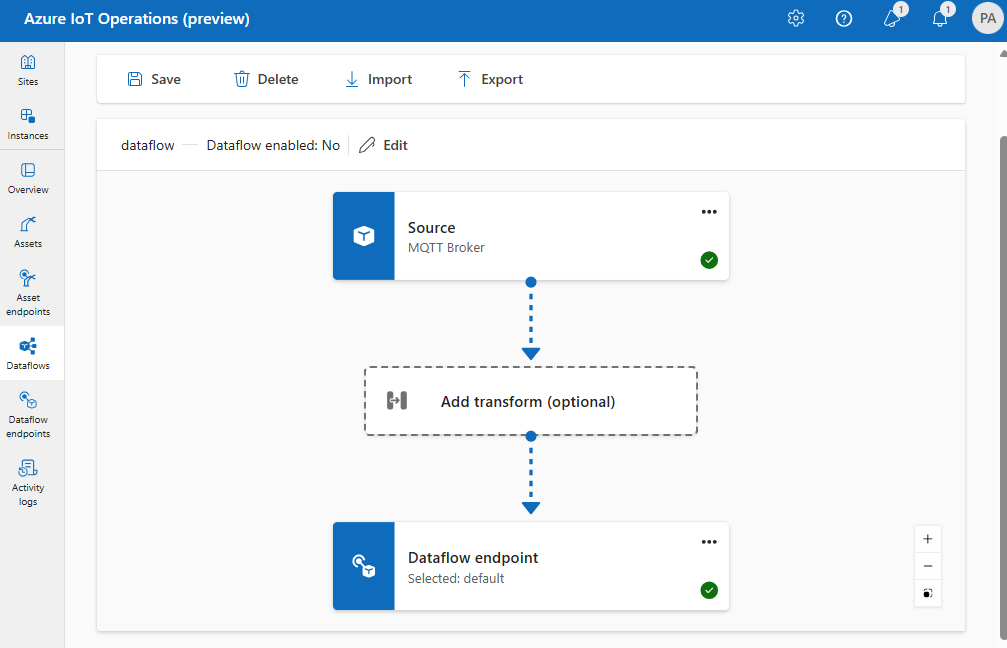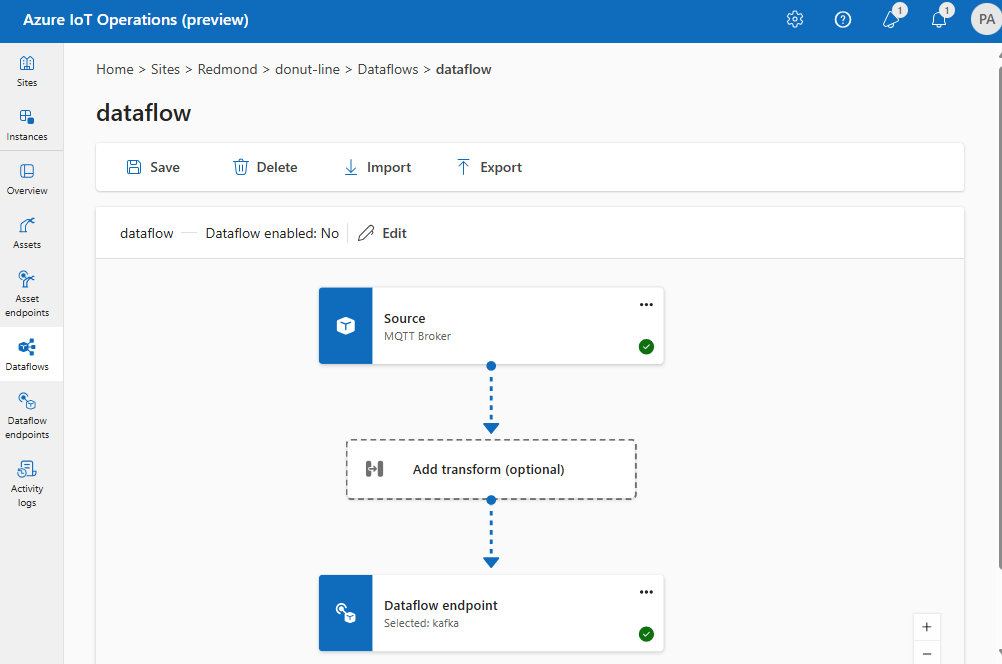Configure dataflow endpoints
Important
Azure IoT Operations Preview – enabled by Azure Arc is currently in preview. You shouldn't use this preview software in production environments.
You'll need to deploy a new Azure IoT Operations installation when a generally available release becomes available. You won't be able to upgrade a preview installation.
For legal terms that apply to Azure features that are in beta, in preview, or otherwise not yet released into general availability, see the Supplemental Terms of Use for Microsoft Azure Previews.
To get started with dataflows, first create dataflow endpoints. A dataflow endpoint is the connection point for the dataflow. You can use an endpoint as a source or destination for the dataflow. Some endpoint types can be used as both sources and destinations, while others are for destinations only. A dataflow needs at least one source endpoint and one destination endpoint.
Use the following table to choose the endpoint type to configure:
| Endpoint type | Description | Can be used as a source | Can be used as a destination |
|---|---|---|---|
| MQTT | For bi-directional messaging with MQTT brokers, including the one built-in to Azure IoT Operations and Event Grid. | Yes | Yes |
| Kafka | For bi-directional messaging with Kafka brokers, including Azure Event Hubs. | Yes | Yes |
| Data Lake | For uploading data to Azure Data Lake Gen2 storage accounts. | No | Yes |
| Microsoft Fabric OneLake | For uploading data to Microsoft Fabric OneLake lakehouses. | No | Yes |
| Local storage | For sending data to a locally available persistent volume, through which you can upload data via Azure Container Storage enabled by Azure Arc edge volumes. | No | Yes |
Dataflows must use local MQTT broker endpoint
When you create a dataflow, you specify the source and destination endpoints. The dataflow moves data from the source endpoint to the destination endpoint. You can use the same endpoint for multiple dataflows, and you can use the same endpoint as both the source and destination in a dataflow.
However, using custom endpoints as both the source and destination in a dataflow isn't supported. This restriction means the built-in MQTT broker in Azure IoT Operations must be either the source or destination for every dataflow. To avoid dataflow deployment failures, use the default MQTT dataflow endpoint as either the source or destination for every dataflow.
The specific requirement is each dataflow must have either the source or destination configured with an MQTT endpoint that has the host aio-broker. So it's not strictly required to use the default endpoint, and you can create additional dataflow endpoints pointing to the local MQTT broker as long as the host is aio-broker. However, to avoid confusion and manageability issues, the default endpoint is the recommended approach.
The following table shows the supported scenarios:
| Scenario | Supported |
|---|---|
| Default endpoint as source | Yes |
| Default endpoint as destination | Yes |
| Custom endpoint as source | Yes, if destination is default endpoint or an MQTT endpoint with host aio-broker |
| Custom endpoint as destination | Yes, if source is default endpoint or an MQTT endpoint with host aio-broker |
| Custom endpoint as source and destination | No, unless one of them is an MQTT endpoints with host aio-broker |
Reuse endpoints
Think of each dataflow endpoint as a bundle of configuration settings that contains where the data should come from or go to (the host value), how to authenticate with the endpoint, and other settings like TLS configuration or batching preference. So you just need to create it once and then you can reuse it in multiple dataflows where these settings would be the same.
To make it easier to reuse endpoints, the MQTT or Kafka topic filter isn't part of the endpoint configuration. Instead, you specify the topic filter in the dataflow configuration. This means you can use the same endpoint for multiple dataflows that use different topic filters.
For example, you can use the default MQTT broker dataflow endpoint. You can use it for both the source and destination with different topic filters:
Similarly, you can create multiple dataflows that use the same MQTT endpoint for other endpoints and topics. For example, you can use the same MQTT endpoint for a dataflow that sends data to an Event Hub endpoint.
Similar to the MQTT example, you can create multiple dataflows that use the same Kafka endpoint for different topics, or the same Data Lake endpoint for different tables.
Next steps
Create a dataflow endpoint:

